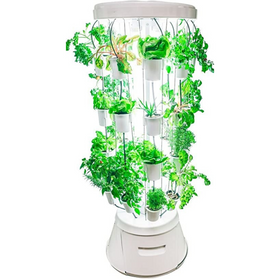
Three Awe-Inspiring Examples of Permaculture
Last Updated: Apr 13, 2025As permaculture continues to gain popularity around the world and more people become certified to design, it’s fair to ask to see some already established systems.
There is much to be said about permaculture in the 40 years since its creation, but there don’t seem to be many fully established systems promoting themselves. There appears to be limited peer-reviewed data to back up the claims of permaculture as a successful means of offsetting our current crisis.
So, where can you find functioning permaculture systems?
Where’s the Science?
To begin, we should ask, “where’s the science?” If you search for scholarly topics on permaculture, you are bound to find plenty of articles, books, or citations on the practices and implementation. But if you look up information on yields, soil health, or quality of life, there’s not a lot of data.
Scattered between authors, you’ll find names like Mollison and Holmgren, the creators of the core design of permaculture. Mollison, the author of the design manual, received his degree in biogeography and became a teacher at the University of Tasmania. One of the concepts in his designers’ manual mentions the use of keyline design to direct water efficiently through landscapes, a technique developed by P.A. Yeoman, an Australian mining engineer. These are two examples of the information placed into the original designers’ manual that help with sustainable systems. Information that was developed by professionals of the time, cross-checked, and, where applicable, backed up with citations. The entire designers’ manual includes references at the end of every chapter.
For those looking for more scientific data, there is another field of study that has more mainstream traction while still similar to permaculture. I like to refer to it as permaculture’s “scientific sister,” agroecology. This field was first developed in 1928 and is the fusion of ecological balance with agricultural systems to establish a more sustainable agricultural sector. Within agroecology, there are different layers of study, all using a similar filter of natural sciences to understand the pros and cons of our current systems.
To see the difference in research between the two fields, I search for “permaculture” on Google Scholar was pinged back 23,300 results while agroecology returned 103,000. Though, after 40 years of trial and error experimentation that permaculture does so well, what has come of it?
There are plenty of living examples spread across the world that speak to the success of permaculture. It’s hard to pick a few sites out, but there were three that I found genuinely awe-inspiring.
Table of Contents
- Zaytuna Farm
- Greening the Desert
- Village Homes

Zaytuna Farm
Zaytuna Farm is an excellent example of large-scale permaculture in action. Geoff Lawton—a permaculture consultant, designer, and teacher—took 66-acres of farmland in 2001 and began the gradual regeneration of the landscape. Nearly twenty years later, it is a thriving regenerative farm and permaculture education center.
Whether you dream of one-day trading in your suburban townhouse for a homestead or already have the land and are just looking for a little inspiration, consider watching the Zaytuna Farm walkthrough. It’s a great example of what large properties can become given sustainable permaculture techniques. It’s an excellent way for homesteaders to achieve their dream of resilience and even income if they’re up for the extra work.
Even if large designs aren’t what you are looking for, there is plenty to learn by watching videos or visiting these types of sites. By seeing what they have accomplished and talking about challenges faced, you get a better idea of what to expect if and when you start your home permaculture design.

Greening the Desert
The project restoring Jordan is another excellent example of using permaculture to take a community, exhausted resources, and turn it back into a verdant oasis. Geoff Lawton spearheaded the project in 2009 using both education and design to inspire the local community to join in regreening their homes. Over the last decade, they have been making small solutions as they established a network of local leaders in sustainable practices.
On a site where the climate is consistently is hot and arid, water becomes a precious resource, which is why it plays such a fundamental role in the design. The project makes use of the water multiple times before putting it into the ground. Rain collects and flows from water tanks to showers for greywater collection, the gravity-fed system eventually filters through reed beds before being used for irrigation.
With water now being fed responsibly into the system, pioneer trees were able to regrow, giving the soil a break from the harsh sun and further supporting healthy plant development. The success of regreening small areas of the town caught the attention of locals, expanding the practices to other families and schools. Children are now producing garden vegetables, bringing home nutritious food to their families, and inspiring more to make the change.
With Permaculture Design Certification courses taking place on-site, an increasing number of locals have become graduates and begun designing their systems as well as helping others.

Village Homes
Village Homes is a great example of permaculture at work in a small suburban community. Located in Davis, California, Village Homes began construction in 1975 and continues to function to this day. The 70-acre subdivision has 225 homes with various amenities and recreational areas for residents. Scattered along the neighborhood is 23 acres of agricultural land and common areas for community use.
California is prone to the heat island effect, especially during the oppressive heat of summer. This community’s solution was to narrow the streets, reducing the amount of road to heat up, and planting trees that would shade it. And to water those trees? Instead of taking from the drought-stricken California water system, they created swales to direct stormwater to thirsty trees and plants.
Bike and pedestrian paths weave between homes and create an environment that encourages residents to leave the car behind. And with fruit and nut trees scattered around the community, why would you want to speed past this edible landscape?
A significant part of the concept of permaculture is the idea of using the community to harbor resilience. But we all know that with any significant population of people problems are bound to arise. Every homeowner is unique, meaning we all have different ideas of what is right for our community. And that’s more than okay. It’s amazing!
It’s essential to realize the best way to create stable communities is through that diversity of characters. One of the permaculture principles teaches us to value diversity and not just in the species we plant but in the personalities that make up our greater community. A thriving community uses communication and hard work to piece together the jigsaw puzzle of figures to build resilience in more ways than one. Practices like community composting, local currencies, and, of course, the adage “it takes a village” are examples of groups coming together to build internal resilience. Bianca Heyming has a great TED Talk on intentional communities and how that connectedness works.
Whether you are starting your homestead, looking to restore a derelict part of town, or create self-reliance in the food desert of the suburbs, permaculture can be used as a lens to filter what strategies have already been shown to work on your site.
Tanner Sagouspe
Tanner Sagouspe has a Masters in Environmental Management and is a Permaculture Designer who promotes tackling the climate crisis at home.










